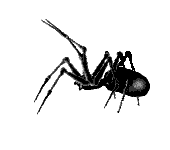WILD FLOWERS OF EAST TEXAS
Page 6
A small collection of plants found by Leona Halley Henderson
|
![[henbit.gif]](pic/henbit.gif) |
Today, 28 Feb 2000, from my back garden I found this bit of Henbit.
(Lamium amplexicaule) Not a very good specimen, as it's a bit early in the season and the garden where it's growing is still not getting much sun. In some areas and later it will be much more compact and the little lavender blooms will be more apparent. This scan is larger than life and because of the shape of the subject, being 3 dimensional and very delicate, was difficult to get it scanned without squashing it, hence it is a bit out of focus.
It seems to have been introduced from Europe?? but is wild all over North America. It likes to grow in grassy areas or will take over where the soil has been disturbed and not heavily mulched. The leaves on the upper stems are clasped around the stem so perfectly that they look just like one leaf with the stem growing up through the center of it. The little reddish purple blooms grow at the base of the leaf in a cluster and with the tight clasp of the two leaves, makes it look like a wreath around the stem. I expect these to be around and blooming up through May. I also checked the Rosemary in the garden today and got a good bloom from it scanned for the herb section
|
![[weed4.gif]](pic/weed4.gif) |
Saw Leaf Daisy !
21 Sept 1999
This strange looking plant from a patch near a ditch on my son's
property. The SAW LEAF DAISY grows quite tall, about 3 to 5 feet,
and puts forth a single stem for each plant, although on a few of
the plants, another flower head seems to be forming in a leaf whorl
lower on the stalk below the larger head shown here. This flower head
has eight buds in it.
I had a hard time identifying it, but according to the book "Wildflowers of the
Texas Hill Country" by Marshall Enquest which has a perfect photo of it, [page 214]
it is a Saw-Leaf Daisy (Prionopsis ciliata); a Compositae, Tribe
Astereae!! Actually, this scan is a little larger than life but I wanted it to be as clear as possible for identification.
Bloom periods: August to November. NOW, does anyone know if it
has any herbal values? |
![[Texas
Poinsettia]](pic/poinstex.gif) |
Euphorbia cyathophora (Poinsettia
cyathophora)
This Texas Poinsettia grows wild and I was blessed with a number of
volunteers among the other plants in my garden this summer. They seem to
do especially well about every seven years and may be noticeably absent
some years in between.
The scan of this sprig was taken 4 Oct 1999. It grows on a single
stem, branching out somewhat like a tree and with varying leaf shapes on
the same plant. The scan is pretty much the same size as the specimen.
The blooming period is from June to October in south-west Smith County.
Looks like it may continue until frost. The color rendition here is not
too good, as the plant is a much clearer green and the red is much
brighter and fresher. |
![[milk1.gif]](pic/milk1.gif ) 21 Nov 1999
21 Nov 1999
Nearly 20 years ago a Mr. Lockhart, a nursery-man, pinched a
tip off of a beautifully shaped plant in his greenhouse and gave it to
me. I had tried to buy the plant but he said it wasn't for sale. I was
so pleased to get the slip that I failed to learn what it was. I have
given many many folks a slip from it and still none of us know what it
is. He, Mr. Lockhart, passed away some years back so ... anyway, the
scan is a bit smaller than a normal fully grown cluster of leaves, and
the whole plant, roots, stem, and leaves are filled with white milky
glue-like substance. One of my neighbors got some on her finger and
touched it to her lip and tongue and it was like very hot pepper. People
don't always listen when you tell them never to put something in your
mouth unless you know what it is.
 The plant is very easily grown, likes a lot of light, a tropical;
doesn't like temperature below 60 and when allowed to get too dry or
cold, the leaves curl up and turn a light tan or nearly white. Anyone
know what it is and its uses,e-mail
me and let me know and then we will both know and I will be
indebted to you!
The plant is very easily grown, likes a lot of light, a tropical;
doesn't like temperature below 60 and when allowed to get too dry or
cold, the leaves curl up and turn a light tan or nearly white. Anyone
know what it is and its uses,e-mail
me and let me know and then we will both know and I will be
indebted to you!
 |

|

|
![[henbit.gif]](pic/henbit.gif)
![[weed4.gif]](pic/weed4.gif)
![[Texas
Poinsettia]](pic/poinstex.gif)
![[milk1.gif]](pic/milk1.gif ) 21 Nov 1999
21 Nov 1999 The plant is very easily grown, likes a lot of light, a tropical;
doesn't like temperature below 60 and when allowed to get too dry or
cold, the leaves curl up and turn a light tan or nearly white. Anyone
know what it is and its uses,
The plant is very easily grown, likes a lot of light, a tropical;
doesn't like temperature below 60 and when allowed to get too dry or
cold, the leaves curl up and turn a light tan or nearly white. Anyone
know what it is and its uses,

